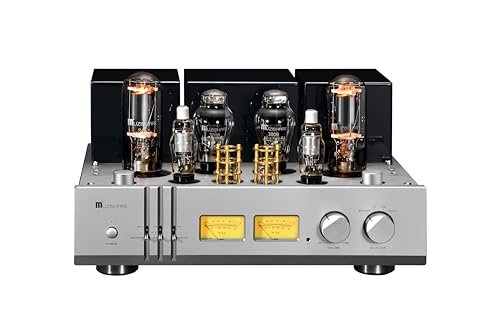Muzishare X30 High-Quality Tube Amplifier
The Muzishare X30 is a Class A single-ended integrated tube amplifier that pairs a 300B tube as the driving/voltage stage with an 845 power output stage, delivering about 30W of output. That specific tube pairing—300B driving 845—is central to the X30’s sonic identity. Below I explain what each tube contributes, how they interact in a Class A single-ended topology, the resulting sound characteristics, and practical listening considerations.
What each tube brings to the chain
-
300B (drive/voltage stage):
- Classic triode sound: warm, musically rich midrange and natural harmonic structure.
- Delivers voltage gain and the tonal “color”—smooth top end and pleasing even-order harmonics.
- Provides the front-end linearity and micro-dynamic refinement that define tube sound.
-
845 (output/power stage):
- Large high-power triode known for headroom, authority, and open dynamics.
- Offers significant current and control for a single-ended amplifier—hence the X30’s notable 30W output.
- Contributes extended bandwidth, strong transient capability, and a tauter low end compared with smaller tube outputs.
How the 300B→845 pairing shapes the X30’s sound
The interaction of a musically focused 300B driving a powerful 845 yields a hybrid of “sweetness” and “authority.” Key sonic outcomes include:
- Midrange presence and warmth: The 300B’s classic midband bloom gives vocals and acoustic instruments an immediate, intimate quality—natural timbre and harmonic richness.
- Open dynamics and headroom: The 845 supplies the muscle. Transients feel more effortless and less compressed than many small-triode single-ended designs; crescendos retain control and scale.
- Textured, musical highs: Because the 300B smooths the top end, treble is detailed without being brittle—airy but relaxed.
- Controlled, weighty bass: The 845’s capability yields deeper and firmer bass than typical low-power triode amps, improving rhythm and pace.
- Harmonic character: Expect a predominance of pleasant even-order harmonics from the 300B with the 845 adding lower-order strength—result is musical coloration rather than artificial warmth.
- Soundstage and coherence: Class A single-ended designs tend to present a coherent, three-dimensional soundstage with good depth and vocal focus; the X30 emphasizes musical cohesion over analytical neutrality.
- Soft clipping and graceful overload behavior: When pushed, the amp will compress gracefully rather than rail, preserving musicality at high levels.
Why Class A single-ended matters here
- Class A operation minimizes crossover distortion and keeps the amplifier in a linear conduction region, which enhances the tube-derived harmonic signature.
- Single-ended topology favors even-order harmonics and a “full” midband—this complements the 300B’s natural character.
- Trade-offs include lower efficiency and greater heat, but these are common and expected in high-quality tube designs aimed at listening enjoyment rather than maximum SPL.
Role of build quality and parts (Muzishare X30 specifics)
The X30’s stated attention to materials and assembly directly affects how the 300B/845 pairing performs:
- High-quality tubes (carefully selected) preserve the intended tonal balance and prevent channel mismatch.
- Japanese potentiometers and low‑ESR German/American capacitors in the signal path keep noise low and dynamics intact, allowing the subtle 300B traits to come through transparently.
- Hand-wiring and careful routing reduce crosstalk and distortion artifacts, so the delicate interplay of harmonic textures between driver and output tube remains clear.
- Solid chassis and tube cage reduce mechanical vibration and microphonics that can smear detail in tube systems.
Practical listening and setup considerations
- Speaker matching: The X30’s 30W single-ended output pairs best with speakers of moderate to high sensitivity (typically 88–95 dB/W/m or higher) and reasonably stable impedance. Less efficient, difficult-to-drive speakers will limit maximum volume and dynamic reach.
- Room size: Best results in small-to-medium rooms where 30W can fill the space with realistic dynamics and sweet tonal presence.
- Tube break-in & biasing: Allow proper break-in and, if user-serviceable, check bias/setup according to manual. Well-matched and warmed-in tubes reveal the best midrange bloom and bass control.
- Music genres that shine: Jazz, classical, acoustic, vocal-heavy recordings, and small-ensemble live material will particularly benefit from the 300B’s tonal coloration and the 845’s authority.
- Maintenance and heat: Expect higher operating temperatures and periodic tube replacement; good ventilation and reliable servicing ensure longevity.
Trade-offs and limitations
- Lower damping factor: Compared to solid-state amps, tube SE designs have less damping on drivers—this can affect ultimate control of some speakers.
- Efficiency and headroom: Although 30W from an 845 is substantial for an SE amp, it isn’t a substitute for high-power solid-state amps when driving very inefficient or large-floorstanding speakers in big rooms.
- Cost and upkeep: High-voltage tube circuitry and premium components demand careful handling and occasional tube swaps.
Conclusion
The 300B-driven 845 stage is the heart of the Muzishare X30’s sonic signature: the 300B supplies the warm, harmonically rich midrange and “sweet” tube coloration, while the 845 provides the power, headroom, and authority to make that coloration feel substantial and dynamic. In the X30’s well-executed Class A single-ended design—with high-quality parts and careful wiring—the result is a musical, coherent amplifier that emphasizes vocal presence, tonal richness, and controlled dynamics. For listeners with suitable speakers and a preference for musical immediacy over clinical neutrality, the 300B→845 pairing in the X30 is a compelling combination.
Product reference: Muzishare X30 Class A Single Ended Integrated Tube Amplifier (300B drive → 845 output), approx. price: $4999.


